Approaches That Use Domain-Specific Expertise: Behavioral-Cloning-Based Advantage Actor-Critic in Basketball Games
Abstract
1. Introduction
2. Background
3. Related Work
3.1. Reinforcement Learning
3.2. State Representation, Reward Function, and Episode Classification
3.3. Behavioral-Cloning Algorithm
3.4. Comparison of Proposed Method to Related Works
4. Behavioral-Cloning-Based A2C and Application in Basketball Games
4.1. Behavioral-Cloning-Based A2C
| Algorithm 1 Proposed behavioral-cloning-based A2C. |
|
4.2. Application of Behavioral-Cloning-Based A2C
5. Experiment
5.1. Behavioral-Cloning-Based A2C Experiment
5.2. Conventional FSM-Based AI Match Experimental Results and Analysis
5.3. Expert-Designed FSM-Based AI Match Experimental Results and Analysis
6. Conclusions
Author Contributions
Funding
Institutional Review Board Statement
Informed Consent Statement
Data Availability Statement
Conflicts of Interest
References
- Vinyals, O.; Babuschkin, I.; Czarnecki, W.M.; Mathieu, M.; Dudzik, A.; Chung, J.; Choi, D.H.; Powell, R.; Ewalds, T.; Georgiev, P.; et al. Grandmaster Level in StarCraft II Using Multi-Agent Reinforcement Learning. Nature 2019, 575, 350–354. [Google Scholar] [CrossRef] [PubMed]
- Mnih, V.; Kavukcuoglu, K.; Silver, D.; Rusu, A.A.; Veness, J.; Bellemare, M.G.; Graves, A.; Riedmiller, M.; Fidjeland, A.K.; Ostrovski, G.; et al. Human-Level Control through Deep Reinforcement Learning. Nature 2015, 518, 529–533. [Google Scholar] [CrossRef] [PubMed]
- Bellemare, M.G.; Naddaf, Y.; Veness, J.; Bowling, M. The Arcade Learning Environment: An Evaluation Platform for General Agents. J. Artif. Intell. Res. 2013, 47, 253–279. [Google Scholar] [CrossRef]
- Watkins, C.J.C.H.; Dayan, P. Q-Learning. Mach. Learn. 1992, 8, 279–292. [Google Scholar] [CrossRef]
- Ioffe, S.; Szegedy, C. Batch Normalization: Accelerating Deep Network Training by Reducing Internal Covariate Shift. In Proceedings of the 32nd International Conference on International Conference on Machine Learning (ICML’15), Lille, France, 6–11 July 2015; Volume 37, pp. 448–456. [Google Scholar]
- Shao, K.; Zhu, Y.; Zhao, D. StarCraft Micromanagement with Reinforcement Learning and Curriculum Transfer Learning. IEEE Trans. Emerg. Top. Comput. Intell. 2019, 3, 73–84. [Google Scholar] [CrossRef]
- Jia, H.; Hu, Y.; Chen, Y.; Ren, C.; Lv, T.; Fan, C.; Zhang, C. Fever Basketball: A Complex, Flexible, and Asynchronized Sports Game Environment for Multi-Agent Reinforcement Learning. arXiv 2020, arXiv:2012.03204. [Google Scholar]
- Ng, A.Y.; Harada, D.; Russell, S. Policy Invariance Under Reward Transformations: Theory and Application to Reward Shaping. In Proceedings of the Sixteenth International Conference on Machine Learning (ICML ‘99), Bled, Slovenia, 27–30 June 1999; pp. 278–287. [Google Scholar]
- Goecks, V.G.; Gremillion, G.M.; Lawhern, V.J.; Valasek, J.; Waytowich, N.R. Integrating Behavior Cloning and Reinforcement Learning for Improved Performance in Dense and Sparse Reward Environments. In Proceedings of the 19th International Conference on Autonomous Agents and MultiAgent Systems (AAMAS’20), Auckland, New Zealand, 9–13 May 2020; pp. 465–473. [Google Scholar]
- Bain, M.; Sammut, C. A Framework for Behavioural Cloning. Mach. Intell. 1995, 15, 103–129. [Google Scholar]
- Konda, V.; Tsitsiklis, J. Actor-Critic Algorithms. In Proceedings of the 12th International Conference on Neural Information Processing Systems (NIPS’99), Cambridge, MA, USA, 29 November–4 December 1999. [Google Scholar]
- Mnih, V.; Badia, A.P.; Mirza, M.; Graves, A.; Lillicrap, T.P.; Harley, T.; Silver, D.; Kavukcuoglu, K. Asynchronous Methods for Deep Reinforcement Learning. In Proceedings of the 33rd International Conference on International Conference on Machine Learning (ICML’16), New York, NY, USA, 19–24 June 2016; Volume 48, pp. 1928–1937. [Google Scholar]
- Schaul, T.; Quan, J.; Antonoglou, I.; Silver, D. Prioritized Experience Replay. In Proceedings of the International Conference on Learning Representations (ICLR), San Juan, PR, USA, 2–4 May 2016. [Google Scholar]
- Hasselt, H.V.; Guez, A.; Silver, D. Deep Reinforcement Learning with Double Q-Learning. In Proceedings of the Thirtieth AAAI Conference on Artificial Intelligence (AAAI’16), Phoenix, AZ, USA, 12–17 February 2016; pp. 2094–2100. [Google Scholar]
- Wang, Z.; Schaul, T.; Hessel, M.; Hasselt, H.V.; Lanctot, M.; Freitas, N.D. Dueling Network Architectures for Deep Reinforcement Learning. In Proceedings of the 33rd International Conference on International Conference on Machine Learning (ICML’16), New York, NY, USA, 19–24 June 2016; Volume 48, pp. 1995–2003. [Google Scholar]
- Bellemare, M.G.; Dabney, W.; Munos, R. A Distributional Perspective on Reinforcement Learning. In Proceedings of the 34th International Conference on Machine Learning (ICML’17), Sydney, Australia, 6–11 August 2017; Volume 70, pp. 449–458. [Google Scholar]
- Schulman, J.; Wolski, F.; Dhariwal, P.; Radford, A.; Klimov, O. Proximal Policy Optimization Algorithms. arXiv 2017, arXiv:1707.06347. [Google Scholar]
- Oh, J.; Guo, Y.; Singh, S.; Lee, H. Self-Imitation Learning. In Proceedings of the 35th International Conference on Machine Learning, Stockholm, Sweden, 10–15 July 2018; Volume 80, pp. 3878–3887. [Google Scholar]
- Brockman, G.; Cheung, V.; Pettersson, L.; Schneider, J.; Schulman, J.; Tang, J.; Zaremba, W. OpenAI Gym. arXiv 2016, arXiv:1606.01540. [Google Scholar]
- Vinyals, O.; Ewalds, T.; Bartunov, S.; Georgiev, P.; Vezhnevets, A.S.; Yeo, M.; Makhzani, A.; Küttler, H.; Agapiou, J.; Schrittwieser, J.; et al. StarCraft II: A New Challenge for Reinforcement Learning. arXiv 2017, arXiv:1708.04782. [Google Scholar]
- Samvelyan, M.; Rashid, T.; Witt, C.S.D.; Farquhar, G.; Nardelli, N.; Rudner, T.G.J.; Hung, C.M.; Torr, P.H.S.; Foerster, J.; Whiteson, S. The StarCraft Multi-Agent Challenge. In Proceedings of the 18th International Conference on Autonomous Agents and MultiAgent Systems (AAMAS’19), Montreal, QC, Canada, 13–17 May 2019; pp. 2186–2188. [Google Scholar]
- Kurach, K.; Raichuk, A.; Stańczyk, P.; Zając, M.; Bachem, O.; Espeholt, L.; Riquelme, C.; Vincent, D.; Michalski, M.; Bousquet, O.; et al. Google Research Football: A Novel Reinforcement Learning Environment. Proc. AAAI Conf. Artif. Intell. 2020, 34, 4501–4510. [Google Scholar] [CrossRef]
- Liu, Y.; Wu, F.; Lyu, C.; Li, S.; Ye, J.; Qu, X. Deep dispatching: A deep reinforcement learning approach for vehicle dispatching on online ride-hailing platform. In Proceedings of the 4th International Symposium on Multimodal Transportation (ISMT’21), Nanjing, China, 14–15 December 2021. [Google Scholar] [CrossRef]
- Peng, X.B.; Panne, M.V.D. Learning Locomotion Skills Using DeepRL: Does the Choice of Action Space Matter. In Proceedings of the ACM SIGGRAPH/Eurographics Symposium on Computer Animation (SCA’17), Los Angeles, CA, USA, 28–30 July 2017; pp. 1–13. [Google Scholar]
- Osa, T.; Pajarinen, J.; Neumann, G.; Bagnell, J.A.; Abbeel, P.; Peters, J. An Algorithmic Perspective on Imitation Learning. Found. Trends Robot. 2018, 7, 1–179. [Google Scholar] [CrossRef]
- Ross, S.; Gordon, G.J.; Bagnell, J.A. A Reduction of Imitation Learning and Structured Prediction to No-Regret Online Learning. In Proceedings of the 14th International Conference on Artificial Intelligence and Statistics (AISTATS), Ft. Lauderdale, FL, USA, 11–13 April 2011. [Google Scholar]
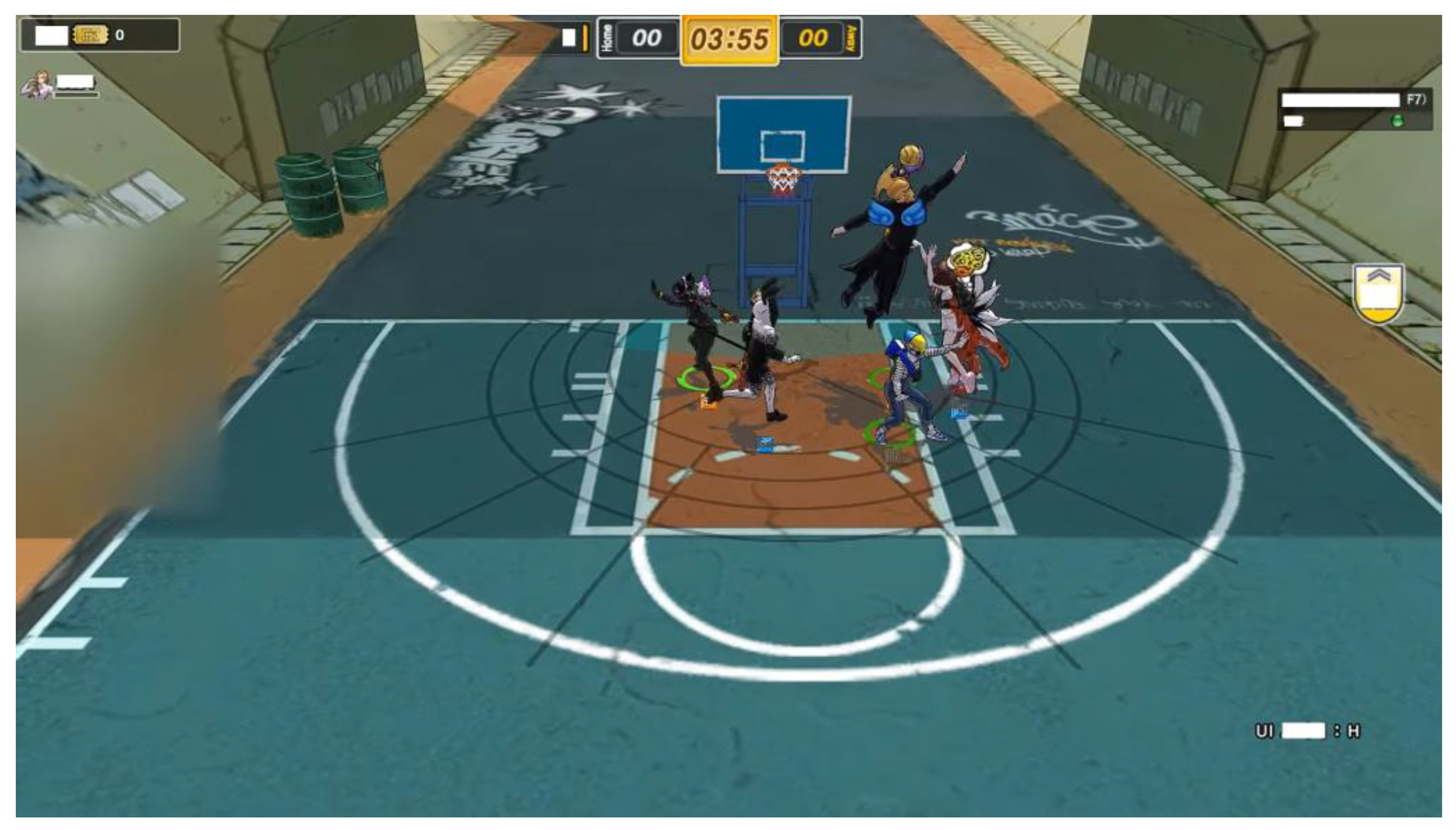
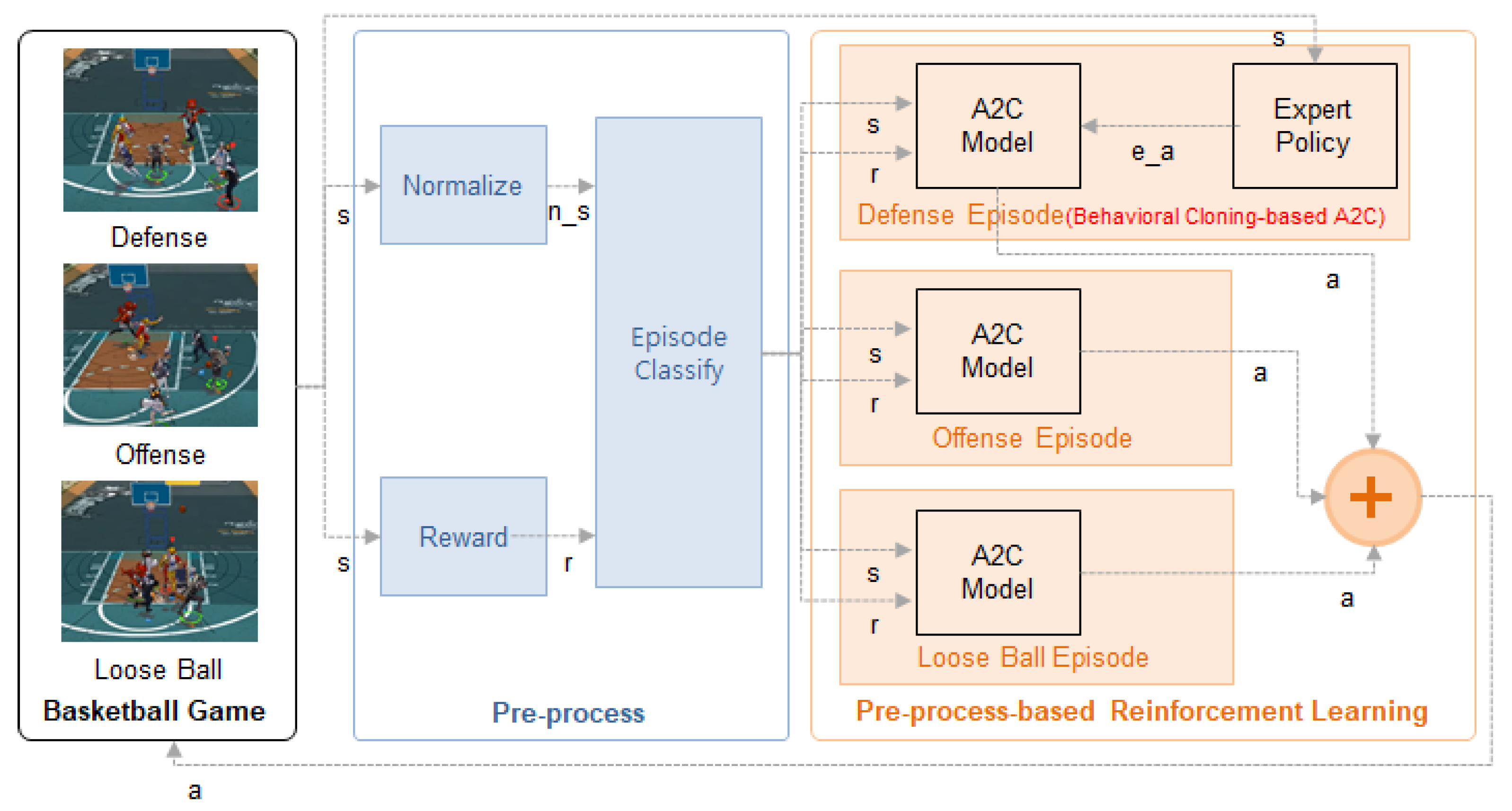

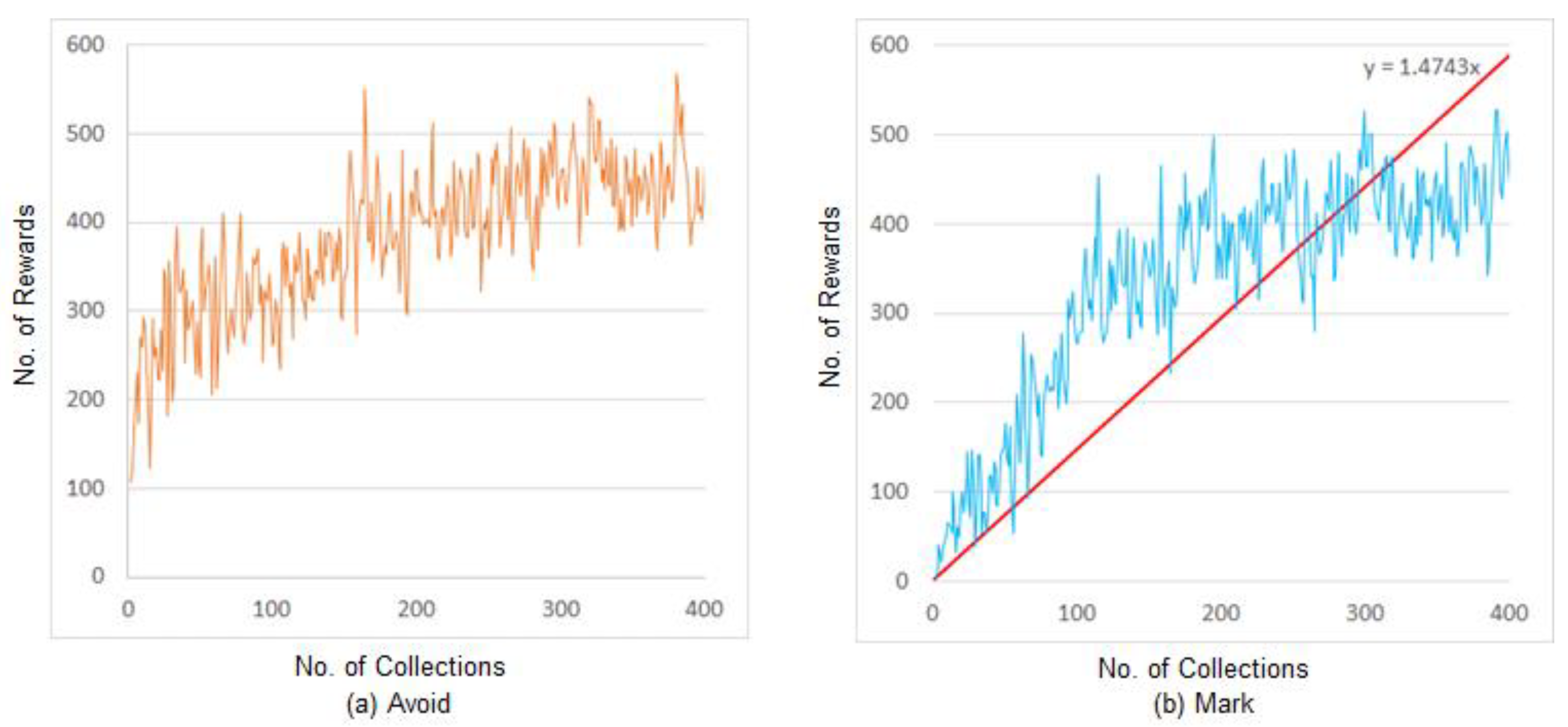
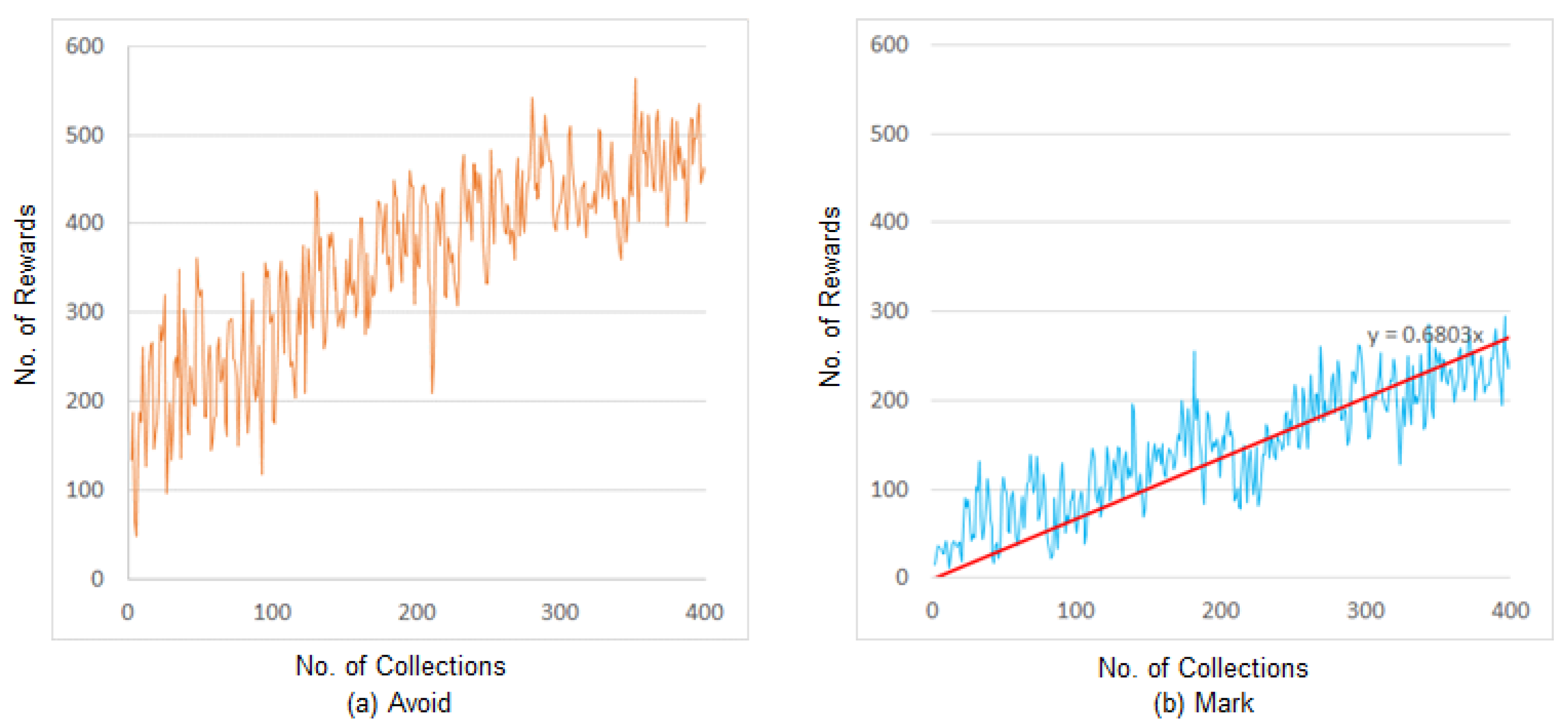
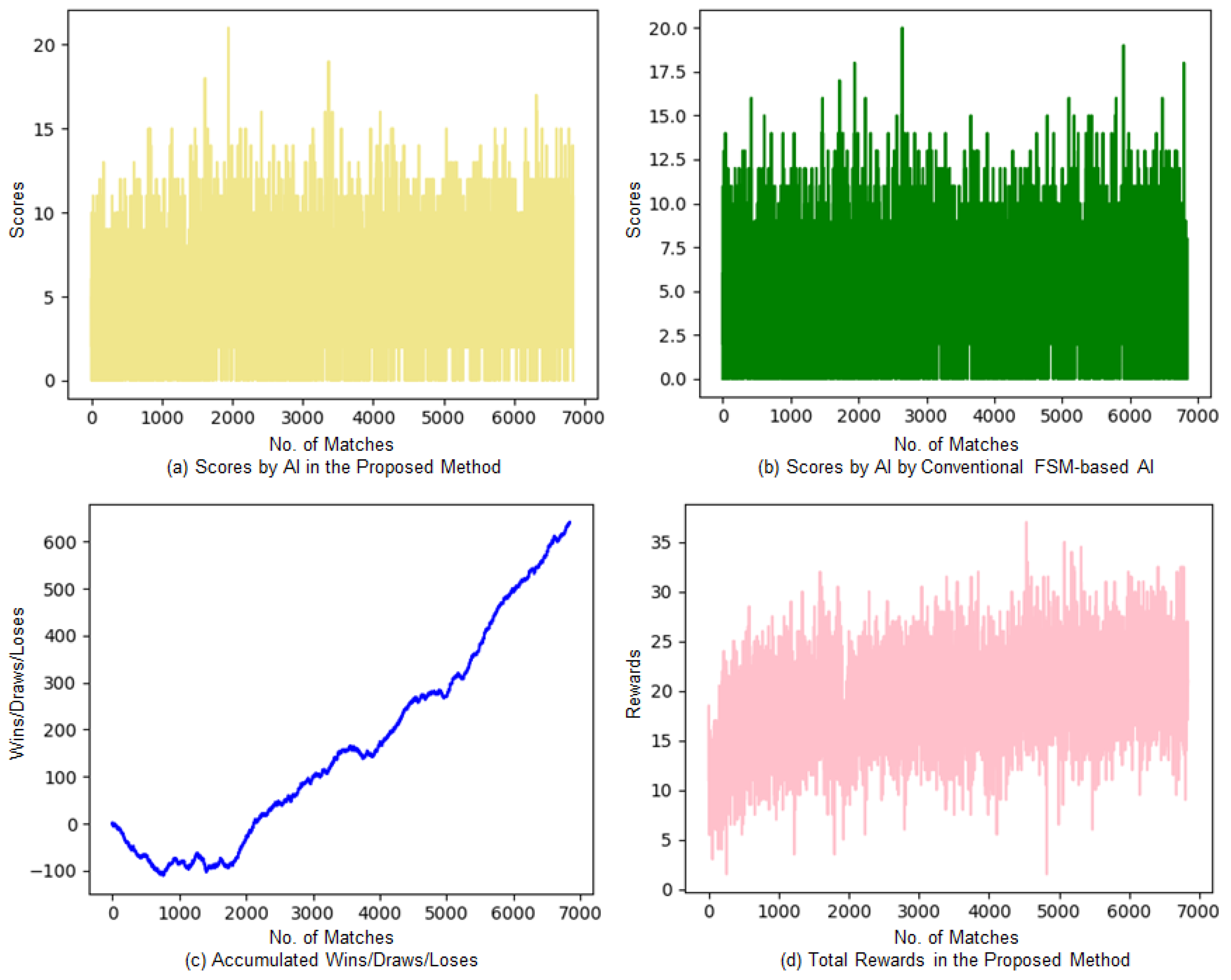

| Ours | Jia et al. [7] | Goecks et al. [9] | |
|---|---|---|---|
| State | Normalized relative values based on basketball game data | Basketball game data | Various values |
| Reward | Values based on state and action | Values based on success of the action | Conventional values |
| Episode | Offense, defense, and loose ball | Attack, assist, defense, free ball, and ball clear | Single episode |
| Algorithm | Behavioral-cloning-based A2C | Multi-agent reinforcement learning | Reinforcement learning that combines imitation learning |
| State | Equation |
|---|---|
| AI location | |
| Team location | |
| Enemy location | |
| Ball location | |
| Ball height | |
| Rim location | |
| Team angle | |
| Enemy angle | |
| Mark angle | |
| Ball distance | |
| Rim distance | |
| Whether ball is clear or not | |
| Whether pivoting or not | |
| Game time remaining | |
| Foul time remaining | |
| Team scores |
| Rewards | Equation |
|---|---|
| Shoot | Shoot status (0.0/1.0) |
| Pass | Pass status (0.0/1.0) |
| Breakthrough | Weighted value (0.5) |
| Mark | Weighted value (0.002) |
| Avoid | Weighted value (0.01) |
| Ball clear | Ball clear status (0.0/1.0) |
| Pick | Weighted value (0.002) |
| Under rim | Weighted value (0.001) |
| Team | 2 Points | 3 Points | Rebound | Block | Steal |
|---|---|---|---|---|---|
| FSM AI | 5.3 | 0.06 | 7.2 | 0.68 | 0.38 |
| Proposed AI | 6.76 | 0 | 2.4 | 5.3 | 2.33 |
Disclaimer/Publisher’s Note: The statements, opinions and data contained in all publications are solely those of the individual author(s) and contributor(s) and not of MDPI and/or the editor(s). MDPI and/or the editor(s) disclaim responsibility for any injury to people or property resulting from any ideas, methods, instructions or products referred to in the content. |
© 2023 by the authors. Licensee MDPI, Basel, Switzerland. This article is an open access article distributed under the terms and conditions of the Creative Commons Attribution (CC BY) license (https://creativecommons.org/licenses/by/4.0/).
Share and Cite
Choi, T.; Cho, K.; Sung, Y. Approaches That Use Domain-Specific Expertise: Behavioral-Cloning-Based Advantage Actor-Critic in Basketball Games. Mathematics 2023, 11, 1110. https://doi.org/10.3390/math11051110
Choi T, Cho K, Sung Y. Approaches That Use Domain-Specific Expertise: Behavioral-Cloning-Based Advantage Actor-Critic in Basketball Games. Mathematics. 2023; 11(5):1110. https://doi.org/10.3390/math11051110
Chicago/Turabian StyleChoi, Taehyeok, Kyungeun Cho, and Yunsick Sung. 2023. "Approaches That Use Domain-Specific Expertise: Behavioral-Cloning-Based Advantage Actor-Critic in Basketball Games" Mathematics 11, no. 5: 1110. https://doi.org/10.3390/math11051110
APA StyleChoi, T., Cho, K., & Sung, Y. (2023). Approaches That Use Domain-Specific Expertise: Behavioral-Cloning-Based Advantage Actor-Critic in Basketball Games. Mathematics, 11(5), 1110. https://doi.org/10.3390/math11051110






